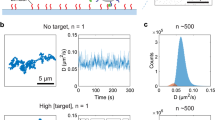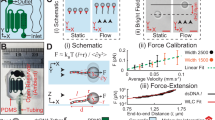Abstract
The past decade has seen researchers develop and apply novel technologies for biomolecular detection, at times approaching hard limits imposed by physics and chemistry. In nearly all sensors, the transport of target molecules to the sensor can play as critical a role as the chemical reaction itself in governing binding kinetics, and ultimately performance. Yet rarely does an analysis of the interplay between diffusion, convection and reaction motivate experimental design or interpretation. Here we develop a physically intuitive and practical understanding of analyte transport for researchers who develop and employ biosensors based on surface capture. We explore the qualitatively distinct behaviors that result, develop rules of thumb to quickly determine how a given system will behave, and derive order-of-magnitude estimates for fundamental quantities of interest, such as fluxes, collection rates and equilibration times. We pay particular attention to collection limits for micro- and nanoscale sensors, and highlight unexplained discrepancies between reported values and theoretical limits.
This is a preview of subscription content, access via your institution
Access options
Subscribe to this journal
Receive 12 print issues and online access
$209.00 per year
only $17.42 per issue
Buy this article
- Purchase on Springer Link
- Instant access to full article PDF
Prices may be subject to local taxes which are calculated during checkout





Similar content being viewed by others
References
The chipping forecast. Nat. Genet. 21, S1 (1999).
The chipping forecast II. Nat. Genet. 32, S4 (2002).
Johnsson, B., Lofas, S. & Lindquist, G. Immobilization of proteins to a carboxymethyldextran-modified gold surface for biospecific interaction analysis in surface-plasmon resonance sensors. Anal. Biochem. 198, 268–277 (1991).
Rich, R.L. & Myszka, D.G. Survey of the year 2001 commercial optical biosensor literature. J. Mol. Recognit. 15, 352–376 (2002).
Morgan, C.L., Newman, D.J. & Price, C.P. Immunosensors: technology and opportunities in laboratory medicine. Clin. Chem. 42, 193–209 (1996).
Kartalov, E.P. et al. High-throughput multi-antigen microfluidic fluorescence immunoassays. Biotechniques 40, 85–90 (2006).
Fritz, J. et al. Translating biomolecular recognition into nanomechanics. Science 288, 316–318 (2000).
Wu, G. et al. Bioassay of prostate-specific antigen (PSA) using microcantilevers. Nat. Biotechnol. 19, 856–860 (2001).
Bergveld, P. Development, operation, and application of ion-sensitive field-effect transistor as a tool for electrophysiology. IEEE Trans. Biomed. Eng. BM19, 342 (1972).
Souteyrand, E. et al. Direct detection of the hybridization of synthetic homo-oligomer DNA sequences by field effect. J. Phys. Chem. B 101, 2980–2985 (1997).
Milovic, N.M. et al. Monitoring of heparin and its low-molecular-weight analogs by silicon field effect. Proc. Natl. Acad. Sci. USA 103, 13374–13379 (2006).
Wang, J. Towards genoelectronics: electrochemical biosensing of DNA hybridization. Chem. Eur. J. 5, 1681–1685 (1999).
Xiao, Y., Lubin, A.A., Baker, B.R., Plaxco, K.W. & Heeger, A.J. Single-step electronic detection of femtomolar DNA by target-induced strand displacement in an electrode-bound duplex. Proc. Natl. Acad. Sci. USA 103, 16677–16680 (2006).
Burg, T.P. et al. Weighing of biomolecules, single cells and single nanoparticles in fluid. Nature 446, 1066–1069 (2007).
Cui, Y., Wei, Q.Q., Park, H.K. & Lieber, C.M. Nanowire nanosensors for highly sensitive and selective detection of biological and chemical species. Science 293, 1289–1292 (2001).
Bunimovich, Y.L. et al. Quantitative real-time measurements of DNA hybridization with alkylated nonoxidized silicon nanowires in electrolyte solution. J. Am. Chem. Soc. 128, 16323–16331 (2006).
Zheng, G., Patolsky, F., Cui, Y., Wang, W.U. & Lieber, C.M. Multiplexed electrical detection of cancer markers with nanowire sensor arrays. Nat. Biotechnol. 23, 1294–1301 (2005).
Stern, E. et al. Label-free immunodetection with CMOS-compatible semiconducting nanowires. Nature 445, 519–522 (2007).
Armani, A.M., Kulkarni, R.P., Fraser, S.E., Flagan, R.C. & Vahala, K.J. Label-free, single-molecule detection with optical microcavities. Science 317, 783–787 (2007).
Benn, J.A. et al. Comparative modeling and analysis of microfluidic and conventional DNA microarrays. Anal. Biochem. 348, 284–293 (2006).
Melin, J. & Quake, S.R. Microfluidic large-scale integration: the evolution of design rules for biological automation. Annu. Rev. Biophys. Biomol. Struct. 36, 213–231 (2007).
Sheehan, P.E. & Whitman, L.J. Detection limits for nanoscale biosensors. Nano Lett. 5, 803–807 (2005).
Bender, C.M. & Orszag, S.A. Advanced Mathematical Methods for Scientists and Engineers (McGraw Hill, New York, 1978).
Hinch, E.J. Perturbation Methods. Cambridge University Press, Cambridge, 1991.
Bird, R.B., Stewart, W.E. & Lightfoot, E.N. Transport Phenomena, edn. 2 (Wiley, New York, 2002).
Leal, L.G. Advanced Transport Phenomena: Fluid Mechanics and Convective Transport Processes (Cambridge University Press, Cambridge, 2007).
Deen, W.M. 123. Analysis of Transport Phenomena (Oxford University Press, New York, 1998).
Squires, T.M. & Quake, S.R. Microfluidics: Fluid physics at the nanoliter scale. Rev. Mod. Phys. 77, 977–1026 (2005).
Berg, H.C. Random Walks in Biology (Princeton University Press, Princeton, 1993).
Newman, J. The fundamental principles of current distribution and mass transport in electrochemical cells. in Electroanalytical Chemistry vol. 6 (ed. Bard, A.) 279–297, (Dekker, New York, 1973).
Ackerberg, R.C., Patel, R.D. & Gupta, S.K. Heat-mass transfer to a finite strip at small Peclet numbers. J. Fluid Mech. 86, 49–65 (1978).
Zhang, W., Stone, H.A. & Sherwood, J.D. Mass transfer at a microelectrode in channel flow. J. Phys. Chem. 100, 9462–9464 (1996).
Peluso, P. et al. Optimizing antibody immobilization strategies for the construction of protein microarrays. Anal. Biochem. 312, 113–124 (2003).
Myszka, D.G., He, X., Dembo, M., Morton, T.A. & Goldstein, B. Extending the range of rate constants available from BIACORE: Interpreting mass transport-influenced binding data. Biophys. J. 75, 583–594 (1998).
Schreiber, G. Kinetic studies of protein-protein interactions. Curr. Opin. Struct. Biol. 12, 41–47 (2002).
Wallis, R., Moore, G.R., James, R. & Kleanthous, C. Protein-protein interactions in Colicin E9 Dnase-immunity protein complexes. 1. diffusion-controlled association and femtomolar binding for the cognate complex. Biochemistry 34, 13743–13750 (1995).
Record, M.T., Zhang, W.T. & Anderson, C.F. Analysis of effects of salts and uncharged solutes on protein and nucleic acid equilibria and processes: a practical guide to recognizing and interpreting polyelectrolyte effects, Hofmeister effects, and osmotic effects of salts. in Advances In Protein Chemistry, vol. 51 (eds. Di Cera, E. & Eisenberg, D.E.) 281–353, (Academic Press, San Diego, 1998).
Belosludtsev, Y. et al. Nearly instantaneous, cation-independent, high selectivity nucleic acid hybridization to DNA microarrays. Biochem. Biophys. Res. Commun. 282, 1263–1267 (2001).
Sosnowski, R.G., Tu, E., Butler, W.F., Oconnell, J.P. & Heller, M.J. Rapid determination of single base mismatch mutations in DNA hybrids by direct electric field control. Proc. Natl. Acad. Sci. USA 94, 1119–1123 (1997).
Riggs, A.D., Bourgeoi, S. & Cohn, M. Lac repressor-operator interaction. III. kinetic studies. J. Mol. Biol. 53, 401 (1970).
Wang, Y.M., Austin, R.H. & Cox, E.C. Single molecule measurements of repressor protein 1d diffusion on DNA. Phys. Rev. Lett. 97, (2006).
Halford, S.E. & Marko, J.F. How do site-specific DNA-binding proteins find their targets? Nucleic Acids Res. 32, 3040–3052 (2004).
Yoon, S.K., Fichtl, G.W. & Kenis, P.J.A. Active control of the depletion boundary layers in microfluidic electrochemical reactors. Lab Chip 6, 1516–1524 (2006).
Vijayendran, R.A., Motsegood, K.M., Beebe, D.J. & Leckband, D.E. Evaluation of a three-dimensional micromixer in a surface-based biosensor. Langmuir 19, 1824–1828 (2003).
Gervais, T. & Jensen, K.F. Mass transport and surface reactions in microfluidic systems. Chem. Eng. Sci. 61, 1102–1121 (2006).
Acknowledgements
T.M.S. gratefully acknowledges National Science Foundation CAREER support (CBET- 0645097) and support from the Los Alamos National Laboratory/UCSB Institute for Multiscale Materials Science for R.J.M. S.R.M. gratefully acknowledges the National Institutes of Health Center for Cell Decision Process Grant (P50-GM68762) and the National Cancer Institute Platform Partnership Grant (R01-CA119402). We gratefully acknowledge T. Burg, J. Han, R. Kamm, S. Quake and H. Stone for critical readings and helpful suggestions.
Author information
Authors and Affiliations
Corresponding author
Supplementary information
Supplementary Text and Figures
Supplementary Figures 1–3, Notes (PDF 882 kb)
Rights and permissions
About this article
Cite this article
Squires, T., Messinger, R. & Manalis, S. Making it stick: convection, reaction and diffusion in surface-based biosensors. Nat Biotechnol 26, 417–426 (2008). https://doi.org/10.1038/nbt1388
Published:
Issue Date:
DOI: https://doi.org/10.1038/nbt1388
This article is cited by
-
Biporous silica nanostructure-induced nanovortex in microfluidics for nucleic acid enrichment, isolation, and PCR-free detection
Nature Communications (2024)
-
Intensity Histogram-Based Reliable Image Analysis Method for Bead-Based Fluorescence Immunoassay
BioChip Journal (2024)
-
Advancing 3D printed microfluidics with computational methods for sweat analysis
Microchimica Acta (2024)
-
Wireless dielectrophoresis trapping and remote impedance sensing via resonant wireless power transfer
Nature Communications (2023)
-
A high-throughput single-particle imaging platform for antibody characterization and a novel competition assay for therapeutic antibodies
Scientific Reports (2023)



